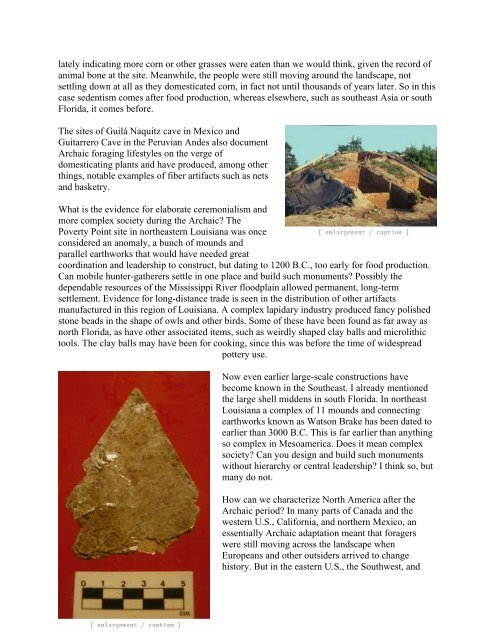INTRODUCTION TO ARCHAEOLOGY Nancy White - Touro Institute
INTRODUCTION TO ARCHAEOLOGY Nancy White - Touro Institute
INTRODUCTION TO ARCHAEOLOGY Nancy White - Touro Institute
You also want an ePaper? Increase the reach of your titles
YUMPU automatically turns print PDFs into web optimized ePapers that Google loves.
lately indicating more corn or other grasses were eaten than we would think, given the record of<br />
animal bone at the site. Meanwhile, the people were still moving around the landscape, not<br />
settling down at all as they domesticated corn, in fact not until thousands of years later. So in this<br />
case sedentism comes after food production, whereas elsewhere, such as southeast Asia or south<br />
Florida, it comes before.<br />
The sites of Guilá Naquitz cave in Mexico and<br />
Guitarrero Cave in the Peruvian Andes also document<br />
Archaic foraging lifestyles on the verge of<br />
domesticating plants and have produced, among other<br />
things, notable examples of fiber artifacts such as nets<br />
and basketry.<br />
What is the evidence for elaborate ceremonialism and<br />
more complex society during the Archaic? The<br />
Poverty Point site in northeastern Louisiana was once<br />
considered an anomaly, a bunch of mounds and<br />
parallel earthworks that would have needed great<br />
coordination and leadership to construct, but dating to 1200 B.C., too early for food production.<br />
Can mobile hunter-gatherers settle in one place and build such monuments? Possibly the<br />
dependable resources of the Mississippi River floodplain allowed permanent, long-term<br />
settlement. Evidence for long-distance trade is seen in the distribution of other artifacts<br />
manufactured in this region of Louisiana. A complex lapidary industry produced fancy polished<br />
stone beads in the shape of owls and other birds. Some of these have been found as far away as<br />
north Florida, as have other associated items, such as weirdly shaped clay balls and microlithic<br />
tools. The clay balls may have been for cooking, since this was before the time of widespread<br />
pottery use.<br />
Now even earlier large-scale constructions have<br />
become known in the Southeast. I already mentioned<br />
the large shell middens in south Florida. In northeast<br />
Louisiana a complex of 11 mounds and connecting<br />
earthworks known as Watson Brake has been dated to<br />
earlier than 3000 B.C. This is far earlier than anything<br />
so complex in Mesoamerica. Does it mean complex<br />
society? Can you design and build such monuments<br />
without hierarchy or central leadership? I think so, but<br />
many do not.<br />
How can we characterize North America after the<br />
Archaic period? In many parts of Canada and the<br />
western U.S., California, and northern Mexico, an<br />
essentially Archaic adaptation meant that foragers<br />
were still moving across the landscape when<br />
Europeans and other outsiders arrived to change<br />
history. But in the eastern U.S., the Southwest, and
















